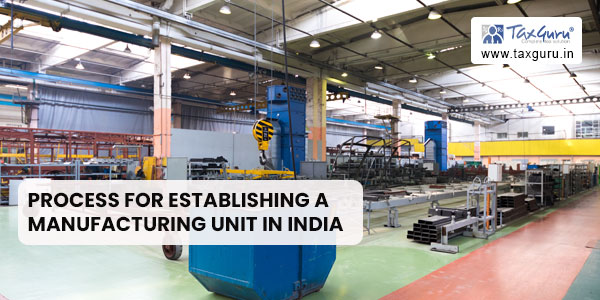From Concept to Reality – Setting Up a Manufacturing Unit in India
Setting up a manufacturing unit in India requires a number of registrations, licenses, and permits. To simplify the registration process, the government has recently unveiled the Udyog Aadhaar Memorandum (UAM). This single page registration is designed to capture the important information of a business unit, thereby eliminating the need to procure multiple registrations. The following is a steps to be followed for setting up a manufacturing unit in India:
Step 1: Develop Your Concept & Business Plan: Before diving into setting up the manufacturing unit, entrepreneurs must have a clean and articulated concept about the product to be manufactured. This can be achieved by conducting a comprehensive market research and identifying customer needs for the proposed product. In order to conceptualize the product, entrepreneurs may also consider current technology & operations available as well as the manufacturing cost and sales/marketing strategies they would use.
Step 2: Prepare Financial Plan: Next, entrepreneurs need to assess the financial requirements for setting up the manufacturing unit, such as the cost of services and production equipment, the cost of premises, electricity, etc., and working capital. Safely budgeting and making provisions for the initial expenses and ongoing costs is essential while setting up the unit.
Step 3: Apply for Licenses and Registrations: Register a business under the correct legal structure and comply with the appropriate labor and business compliances. After that, register the business with all the authorities and agencies, such as Registrar of Companies (ROC), Goods and Services Tax (GST) registration, and more. List of the registration are following:
1. Register for Goods and Services Tax (GST): All businesses must obtain GST registration from the Central Board of Excise and Customs. The GST registration must be obtained in each state where the goods are to be sold. The registration process is conducted online, though the applicant has to provide relevant documents for proof.
2. Obtain Import Export code (IEC): All manufacturing units that are involved in either the import or export of goods require an IEC code. An IEC code provides the business the right to transnational trade goods without any customs duties or taxes. This registration can also be obtained online.
3. Factory registration: An application for a manufacturing unit registration must be submitted to the regional office of the Ministry of Micro, Small and Medium Enterprises (MSME).
4. Building Plans And Construction Permission: Building plans must be submitted to the local Urban Development Authority (UDA) or Municipal Corporation for necessary approvals.

5. Register For Udyog Aadhaar: This is the first and most important step in the registration process. Udyog Aadhaar is a 12-digit unique identification issued to small and medium businesses by the MSME Ministry under the Government of India. This registration is to be done 6. online from the official website of the MSME ministry.
6. Register for Employees Provident Fund: All business must acquire the Employees Provident Fund (EPF) registration as per the EPF & MP Act of 1952. The registration must be done within 21 days of the first employee joining the firm.
7. Register for Employees State Insurance Corporation: All businesses employing over than 20 employees must register with the State’s Employees State Insurance Corporation (ESIC). The registration must be done within 15 days of the employee being on the rolls.
8. Register with the State Labour Department: All manufacturing units must register with the local State Labour Department. The registration is easy and quick as long as all the required documents are in order. The registration is mandatory and must be done within 90 days of the establishment of the facility.
9. Acquiring Trade Marks: The business must register with the Indian Trade Marks Registry for the relevant trademarks/brands for its products/services.
10. Boiler registration: Manufacturing units which use boiler-operated processes must first obtain a Boiler Operation Certificate from the Boiler Inspector Department of the local state.
11. Fire Safety Certificate: A fire safety certificate must be obtained from the local Fire Service Department before commencing the manufacturing operations.
12. Industrial License: A license must be obtained from the Department of Industrial Policy and Promotion (DIPP) for setting up the manufacturing unit.
Step 4: Apply for Legal & Environmental Approvals: Before starting the manufacturing process, entrepreneurs need to fulfill all the legal compliances and governmental approvals. Obtaining NOC for Environment Clearance: Any manufacturing unit that is likely to have an adverse effect on the environment must obtain a No-Objection Certificate from the State Pollution Control Board (SPCB).
Step 5: Source Raw Materials & Equipment: After all the necessary legal and environment-related approvals are in place, entrepreneurs can focus on procuring the raw materials and production equipment to commence production operations. They should consider opting for the best machinery, infrastructure, machinery suppliers, and more for efficient operations.
Step 6: Train & Hire Employees: Hire the right employees to join the team and manage the business development, operations, finance, etc. Provide the necessary training to enhance their skills and make sure they understand their job responsibilities.
Step 7: Start Production: Once all the training and hiring are complete, entrepreneurs can start the production process and manufacture quality products.
Step 8: Start Marketing & Distribution: Finally, the focus should be on marketing and product promotional activities to drive sales. Entrepreneurs can also start to identify potential distributors and channels to market and distribute the product.
In conclusion, setting up a manufacturing unit in India requires a number of registrations, licenses, and permits. To simplify the registration process, the Government has launched the Udyog Aadhaar Memorandum, which serves as a single page registration for new or existing businesses. Finally, businesses must procure trade Marks in order to register relevant brands/trademarks for its products/services.
****
(Author can be reached at email address casharma.sharad2000@gmail.com or on Mobile No. 9990365673)
Disclaimer : “Neither this article nor the information contained herein shall in any way be construed as forming a contract or shall constitute professional advice required before acting upon any matter. CA Sharad Kumar Sharma has taken all due care in the preparation of this article for accuracy in its contents at the time of publication. However, no liability shall be accepted by him in the event of any direct, indirect or consequential damages arising out of or in any way connected with the use of this article or its contents. “





